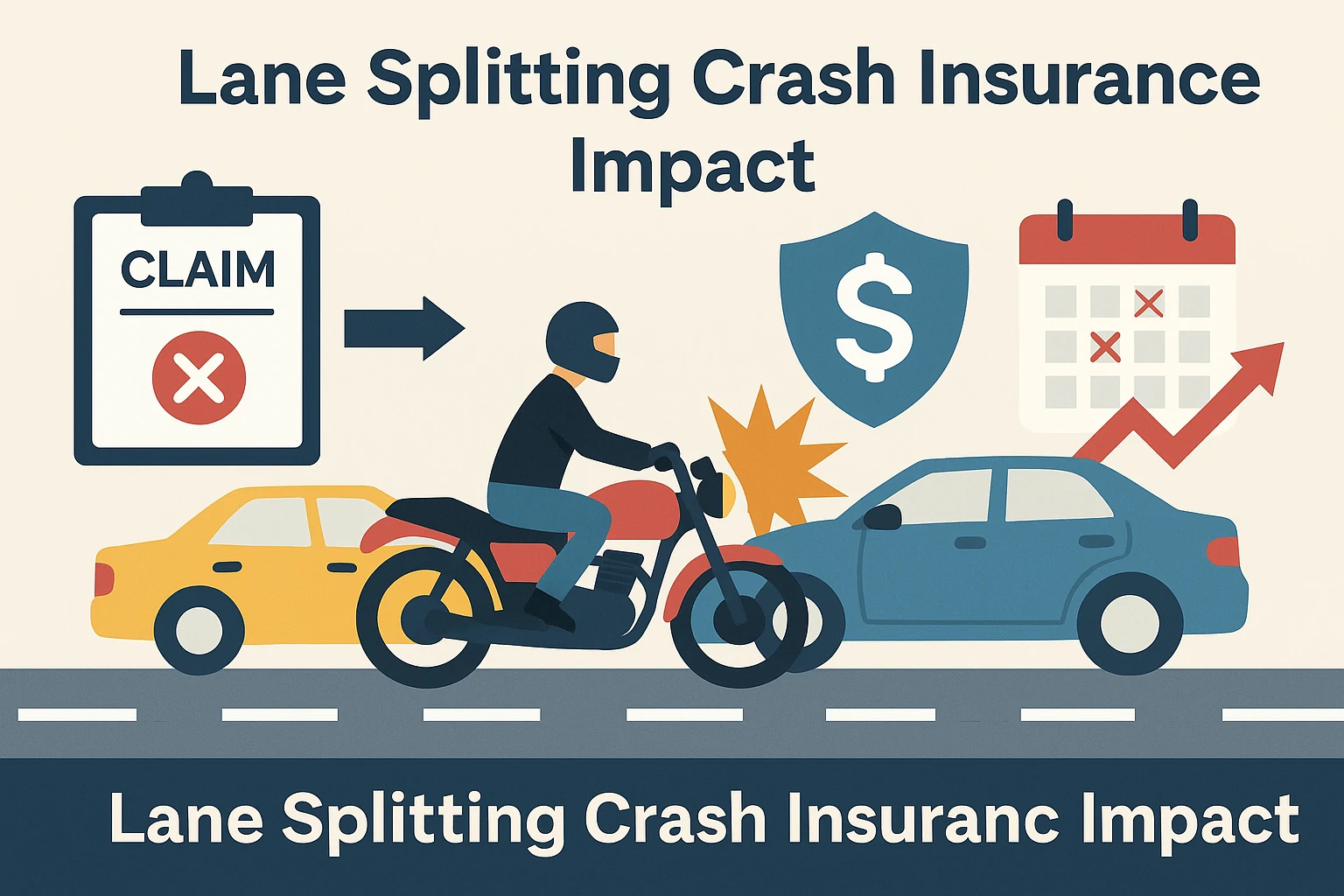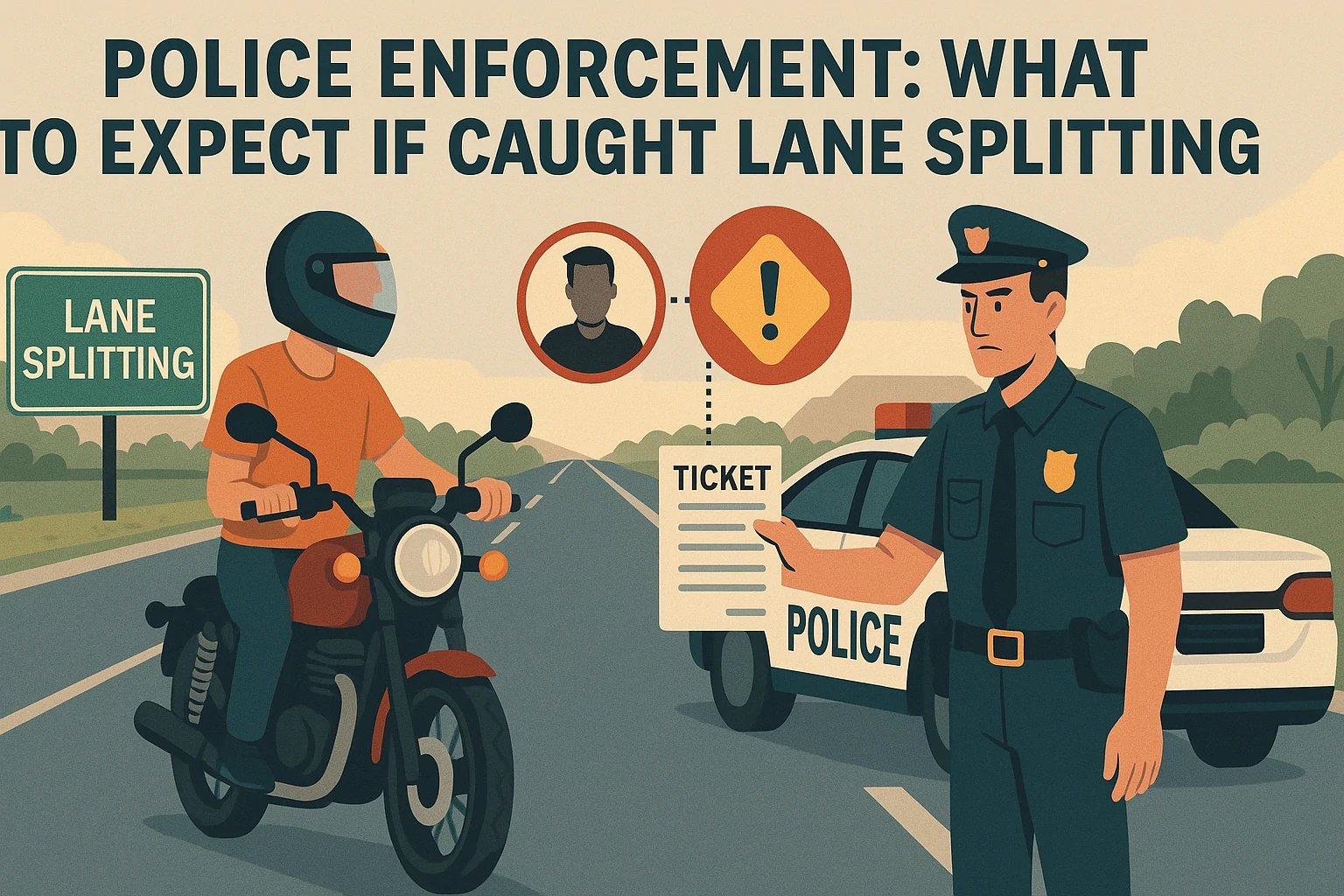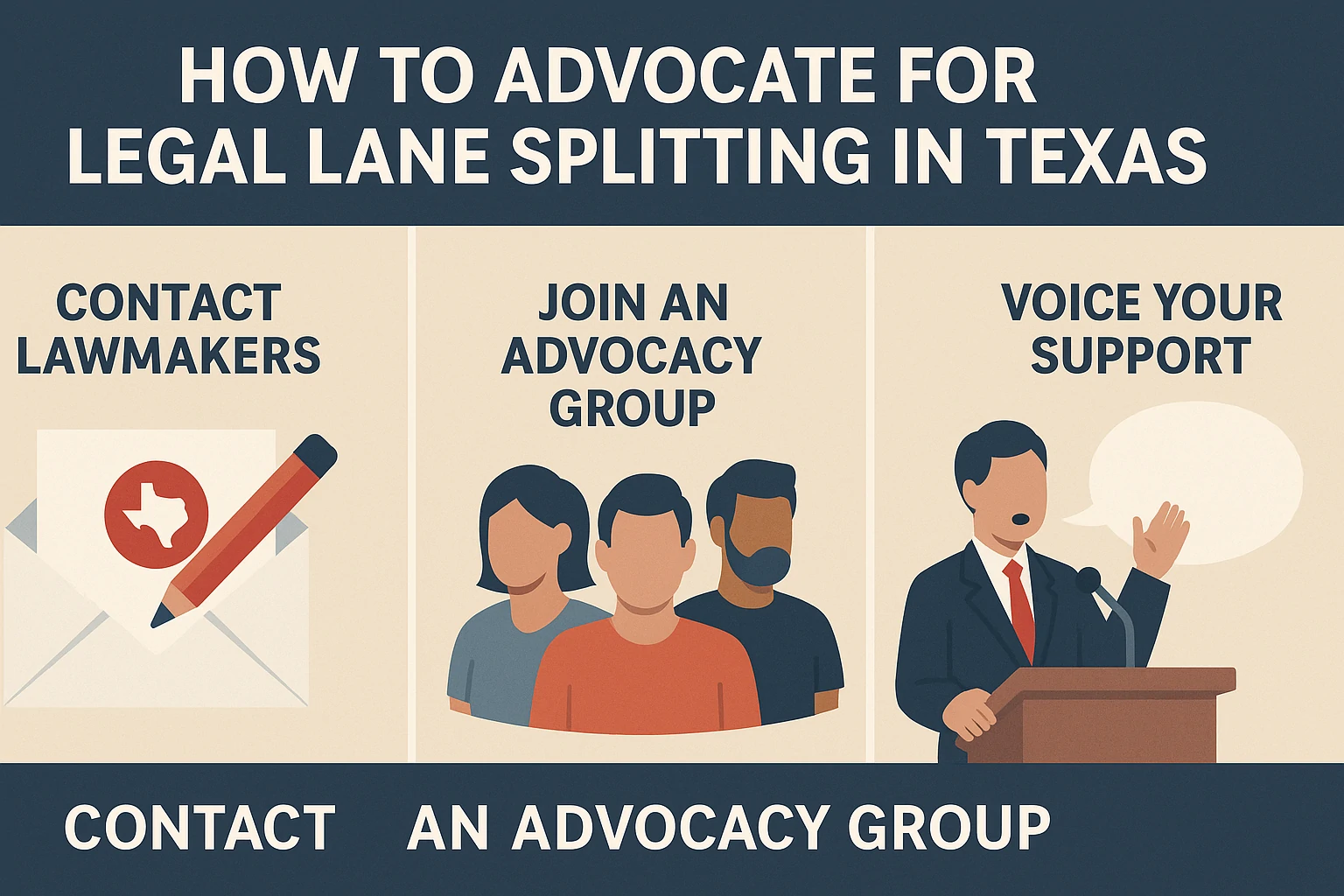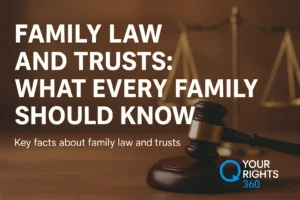Traffic in Texas can stretch for miles. Highways slow down during rush hours. Cities often clog up with long lines of cars. In moments like these, motorcycle riders feel the pressure. Many want a quicker way out. Some try to ride between lanes to save time. This act is called lane splitting.
Lane splitting looks simple to some. It involves a motorcycle riding through the narrow space between two lanes of moving or stopped cars. Riders believe it helps them move faster. Some feel it makes them safer from rear-end crashes. But the law in Texas does not see it that way.
In recent years, Texas lawmakers made changes. They passed a rule that clearly bans lane splitting on Texas roads. The decision is not open to debate. Every motorcyclist must follow this rule or face the consequences. Understanding this law is not just about staying legal. It’s about staying safe.
This article gives you the full picture. You will learn what lane splitting means in Texas, why it is banned, what penalties you might face, and what you can do instead to ride safely. If you own or ride a motorcycle in Texas, this is information you cannot ignore.
What Lane Splitting Really Means
Lane splitting is when a motorcycle moves between two lanes of cars. The motorcycle does not stay behind other vehicles. Instead, it rides in the space between them. The goal is to pass cars that are moving slowly or stopped in traffic. This often happens on crowded highways or busy city roads.
Some riders call it white-lining. Others call it filtering. The names vary, but the action remains the same. A motorcycle uses the narrow gap between lanes to get ahead. This may seem smart when cars are not moving. It may even feel safe to some riders.
But in Texas, this kind of move is not allowed. It goes against the state traffic laws. Once you pass between two active lanes without changing fully into one, you are breaking the rule. That means you could get pulled over, get a ticket, or even face worse legal outcomes. The law does not leave room for guessing.
Lane Splitting vs. Lane Filtering: Know the Difference
| Feature | Lane Splitting | Lane Filtering |
|---|---|---|
| When it happens | Cars are moving | Cars are stopped |
| Where it happens | Between lanes on roads or highways | At traffic lights or in traffic jams |
| Speed | Moderate to fast | Very slow or crawling |
| Legal in Texas | No | No |
| Purpose | Move ahead through moving traffic | Reach the front before light turns |
Texas law treats both actions the same. Riders must not ride between cars, even if traffic is slow or stopped. The rule is clear. One lane at a time, no exceptions.
What the Law Says About It
Texas lawmakers put an end to the debate. They added a new rule that clearly states motorcycles cannot split lanes. The rule says no motorcyclist may ride between lanes of moving traffic. The law also bans passing another vehicle in the same lane. These words leave no space for confusion.
This rule became active in 2023. Before that, the law was vague. Some officers issued tickets for lane splitting. Others let it slide. Riders often didn’t know where the law stood. The new rule changed that. Now, the message is direct and simple. Lane splitting is not allowed on Texas roads.
Police can stop a rider on the spot. They don’t need to explain much. If they see a motorcycle passing cars between lanes, they can write a ticket. The law also gives them the right to treat the move as reckless. That means harsher punishment, higher fines, and possible court action.
The History of Lane Splitting Laws in Texas

Texas did not always have a clear rule about lane splitting. Riders moved between lanes in heavy traffic. Some police stopped them. Others looked the other way. Courts had little to go on. The law was not direct.
Some lawmakers tried to fix the problem. A few bills were proposed in past years. They suggested legalizing lane splitting under strict rules. None of those bills passed. Support was too low.
In 2023, the Texas legislature made a change. They added a new section to the traffic code. It banned lane splitting in plain terms. The new law left no confusion. Now, all riders in Texas must follow this rule on every road.
Why Lane Splitting Is Unsafe
Many riders argue that lane splitting keeps them safe. They believe it reduces the risk of getting hit from behind in traffic. But most crashes don’t come from the rear. They happen from the side, from blind spots, or from sudden lane changes. Lane splitting puts riders in these danger zones.
Drivers do not expect motorcycles between lanes. They focus on the car ahead, not on what might pass beside them. If a driver shifts lanes without warning, a motorcycle caught in the middle has nowhere to go. The space is too tight. A quick move can lead to serious harm.
Texas roads also bring their own risks. Many have uneven pavement, cracks, potholes, and debris. A rider who tries to pass between lanes may not see these hazards in time. With no space to dodge or swerve, the chance of a crash grows fast.
Blind spots make things worse. Most cars and trucks have large areas where the driver cannot see. Motorcycles are small and easy to miss. When a rider enters that blind space, the risk of a collision goes up. Lane splitting increases this exposure.
Crashes and Legal Fault
If a motorcycle splits lanes and ends up in a crash, the law does not help the rider. Texas follows a fault system. If you are more than 50 percent at fault for a crash, you cannot collect money. That means if lane splitting caused or added to the crash, the rider may get nothing.
Even if the other driver made a mistake, the illegal act of lane splitting can tip the case against the rider. Courts follow the law. Insurance companies also look at fault. They check the police report. If the report says you split lanes, your claim may get denied.
Riders who break the rule risk more than injury. They risk losing their right to sue for damages. They risk paying for the crash themselves. That includes bike repairs, medical bills, and more. One bad decision can cost thousands.
What Happens to Insurance After a Lane Splitting Crash

Insurance companies review all details after a crash. If the rider was lane splitting, the report often shows they broke the law. That one fact can hurt the rider’s claim. The insurer may say the rider caused the crash. They may reduce the payout or deny it fully.
Texas follows a fault system. If the rider is more than 50 percent at fault, they lose the right to collect money. Lane splitting, even without a crash, shows risky behavior. In court or during a claim, this can turn the case against the rider fast.
Even if the rider gets some money, the company may raise their premium. Future claims may cost more. Some insurers may even cancel the policy. All this can happen from one illegal move in traffic. Riders who stay legal protect their coverage and their wallet.
How Lane Splitting Impacts Motorcycle Accident Claims
Insurance companies check fault in every crash. Lane splitting makes that process harder for riders. If the report says you split lanes, the insurer may blame you. That can lower or cancel your payout.
Even if another driver made a mistake, your illegal move hurts your case. Courts may say you took a known risk. That reduces sympathy and money.
Some riders believe fault rules protect them. But Texas uses a system that blocks recovery if you’re more than 50 percent at fault. Lane splitting can push you over that limit. Always think about how actions affect claims.
Tickets, Fines, and Insurance Costs
Getting caught lane splitting brings more than a warning. Police can issue a ticket right away. The fine may range from a small fee to several hundred dollars. It depends on how the act is judged. Some riders may face reckless driving charges. That makes the case more serious.
A reckless driving charge can lead to court. If found guilty, you may face a license suspension, community service, or even jail in rare cases. You may also see higher insurance costs. Companies view risky riders as expensive. One ticket may raise your premium. More than one may cause cancellation.
Even without a crash, the price of breaking this rule adds up. Tickets, points on your license, court fees, and insurance hikes make lane splitting a costly mistake.
Police Enforcement: What to Expect If Caught Lane Splitting

Police in Texas now watch closely for lane splitting. If they see a motorcycle move between lanes, they may stop the rider right away. The officer does not need to give a warning first. The law gives clear authority to take action on the spot.
The rider may get a traffic ticket. In some areas, the fine may be small. In others, it may cost a few hundred dollars. If the officer believes the move was dangerous, they may charge the rider with reckless driving. That charge can lead to bigger fines and even court.
Some riders try to explain or argue at the scene. That often makes things worse. The best move is to stay calm. Show your license and insurance. Ask questions politely if needed. Then leave the scene safely. Fighting the ticket comes later, not on the roadside.
What to Do If You’re Ticketed for Lane Splitting
If police stop you for lane splitting, do not panic. Stay calm and respectful. Give your license and proof of insurance. Let the officer explain the reason for the stop. Do not argue.
If you get a ticket, read it closely. It will tell you the fine and court date. You have two choices. You can pay the fine or contest the ticket in court. If you choose to fight it, speak to a traffic lawyer. They can help you build a defense.
Do not ignore the ticket. That could lead to more fines or a suspended license. Handle it on time. Learn from the event. Stay in your lane and avoid the same mistake again.
What Riders Should Do Instead
Texas law gives motorcycles full rights to the lane. You do not have to ride on the edge. You can take up the entire lane. Use it. Ride in a visible position. Stay out of blind spots. Do not feel pressure to squeeze through traffic.
Texas also allows two motorcycles to ride side by side in one lane. This is called lane sharing. It must be done safely and with agreement. If traffic allows, it can be a smart way to ride with a partner. But it is not the same as lane splitting.
Plan your trips with time in mind. Avoid the busiest hours if possible. Choose routes that have steady flow. Take the roads with fewer stops. These steps help you stay calm and safe. You won’t feel the need to rush.
Wear bright colors. Keep your lights on. Use hand signals. Make sure drivers can see you. Stay at a speed that gives you control. Leave room between you and the car in front. These habits save lives.
Legal Alternatives to Lane Splitting in Texas

Texas law gives riders full use of their lane. You do not need to ride on the edge or give up space to cars. You have the right to ride in the center. This helps drivers see you. It also gives you room to react if danger appears.
Two motorcycles may share one lane. This is called lane sharing. It is legal in Texas when done safely. Both riders must agree. They must also make sure traffic allows it. Never ride too close or block others. Keep your space and stay alert.
Smart planning helps avoid traffic. Choose roads with fewer stops. Ride during off-peak hours. Use side streets when highways back up. These moves follow the law and reduce stress. You get where you need to go without breaking rules or risking tickets.
What Happens After a Crash
After a crash, police arrive fast. They take control of the scene. They speak to all parties. If the rider was lane splitting, they note it in the report. That detail shapes the rest of the case.
The insurance company uses that report. If it says you split lanes, they may call you at fault. They may reduce or deny your payout. You may lose your chance to recover money. The court will likely agree. Breaking the law makes your case weak.
Even if you feel the other driver caused the crash, your illegal move hurts your defense. In court, facts matter. Lane splitting goes against the rule. That fact turns the case.
Always take photos at the scene. Get contact details from witnesses. Save medical records and repair bills. If needed, speak to a lawyer. But even the best lawyer may not undo the damage caused by lane splitting.
Why Texas Made It Illegal
Texas banned lane splitting for a reason. The lawmakers wanted safer roads. They looked at the risk. They spoke to drivers, riders, and police. They chose to keep motorcycles in lanes, not between them.
Most drivers in Texas do not expect bikes in tight spaces. When a motorcycle appears between lanes, it surprises the driver. That surprise leads to quick reactions, often unsafe ones. These fast moves cause crashes.
Lawmakers saw that the risks were high. The benefit was small. Riders saved a few minutes. But those minutes were not worth the danger. The law now protects both sides.
Some states allow lane splitting. Texas does not. The roads here are different. The traffic style, speed, and volume shape the law. What works in one state may fail in another. Texas made its choice based on what it knows best.
Do Any Texas Cities Support Lane Splitting?
Some riders believe certain cities might allow lane splitting. They hope local rules can make a difference. In Texas, that is not the case. No city or county can override state traffic law.
The ban on lane splitting applies across the entire state. It does not matter if you ride in Houston, Dallas, Austin, or a small town. Police in every area follow the same rule.
Even if a local officer does not stop you, the law still applies. Courts will treat the action the same in every Texas city. Always follow the state rule. Do not assume local customs give you a pass.
Will Texas Change Its Mind?
Some people hope the law will change. They want Texas to allow lane splitting. They say it saves time. They say it helps riders stay safe. They bring studies and facts. But change takes time.
Right now, there is no sign of a new law. The rule stays in place. Lane splitting remains illegal. Until lawmakers act, riders must follow the current rule. Hopes do not change laws. Only action in the statehouse can do that.
If a new bill appears, it may bring limited rules. It may allow splitting at low speeds. It may set guidelines. But until then, you cannot split lanes and stay legal in Texas.
How to Advocate for Legal Lane Splitting in Texas

Some riders believe lane splitting should be legal in Texas. They feel it could ease traffic and prevent rear-end crashes. If you agree, there are ways to support change without breaking the law.
Start by reaching out to your local lawmakers. Call or email your state representative. Tell them your views. Explain how lane splitting works in other states. Share facts, not just opinions.
Join a motorcycle rights group. These groups often speak directly to lawmakers. They help raise awareness and push for new bills. When riders unite, their voice gets stronger. Lawmakers pay attention to organized action.
Watch for new proposals in the Texas legislature. Speak in public meetings if you can. Vote for leaders who support rider safety. Change takes time, but every voice matters. If enough people act, the law can evolve.
Why California Allows It and Texas Doesn’t
California was the first state to allow lane splitting. Officials there studied rider behavior and traffic flow. They made rules that guide how and when a rider can move between lanes. Riders must stay within safe speed limits. They must split only when traffic moves slowly. Drivers in California know what to expect.
Texas looked at the same issue but chose a different path. Lawmakers here saw more risk than reward. They believed lane splitting would cause more crashes. They said Texas roads and drivers were not ready for such a move. The goal was to keep roads simple and safe for all users.
Each state makes its own laws. What works in California may not work in Texas. The two states took opposite views. Texas chose to ban it. California chose to guide it. Riders must follow the rules where they ride. No state shares the same traffic system.
States Where Lane Splitting Is Legal
Texas bans lane splitting. But a few states allow it under limits. California was the first to make it legal. Riders there can split lanes at safe speeds when traffic is slow.
Arizona and Utah allow lane filtering in very limited ways. Montana recently passed a law that allows filtering in stopped traffic. These states set rules on when and how it works. Most still ban full-speed lane splitting.
Always check the law before you ride in a new state. Just because one place allows it does not mean others do. Learn the rules. Ride legal in every state.
Some road rules vary from state to state. For example, jaywalking laws in California differ from what most people expect. Lane splitting laws follow the same pattern, each state decides its own rules.
How to Ride Smart in Texas
Use your lane. Ride where cars can see you. Keep safe space in front and behind. Avoid sudden moves. Signal before turning or changing lanes. These actions protect you.
Watch the road. Look ahead for danger. Slow down near traffic jams. Keep your eyes on mirrors and your hands ready. Take your time. Speed leads to mistakes. Stay calm and steady.
Take a safety course. Learn from experts. Practice your skills. Know how to stop fast, turn sharp, and avoid danger. A trained rider stays safe.
Wear the right gear. A helmet, jacket, gloves, and boots do more than look good. They protect your body. One crash can change your life. Good gear reduces harm.
Conclusion
Lane splitting is not legal in Texas. The law says riders must stay in one lane. Moving between cars, even in slow traffic, breaks the rule. The ban is clear. Police can stop you. Courts can fine you. Insurance companies may deny your claim if a crash happens.
Many riders feel the rule limits their freedom. Others say it protects them. No matter the view, every rider must follow the law. That is how you stay safe and avoid trouble. Texas roads move fast and slow. Staying in your lane is the best way to stay in control.
You have rights. Use your full lane. Ride with care. Plan your routes. Make smart choices. Protect yourself and others. Respect the law even if you want it to change.
If you believe lane splitting should be legal, take action the right way. Speak up. Join with others. Ask for reform through the law, not around it.
Until that day comes, ride smart, ride safe, and stay in your lane.
Check the legal drinking age in Mexico if you plan to travel there.
Common Questions
Q. Is lane splitting allowed on highways in Texas?
Texas law does not allow lane splitting on highways or any public road. Riders must stay within their lane at all times, even during traffic jams.
Q. Can a police officer arrest you for lane splitting?
A police officer can stop a rider for lane splitting and issue a ticket. If the officer believes the action was reckless, they may charge it as a higher offense. That charge could lead to arrest in rare cases.
Q. How much is the fine for lane splitting in Texas?
The fine can range from under $200 to several hundred dollars, depending on the court and county. In some cases, reckless driving charges may raise the cost or lead to court action.
Q. Does lane splitting affect insurance claims after a crash?
Lane splitting can hurt your insurance claim. If the report shows that you broke the law, your insurer may lower or deny your payout. Courts may also see you as at fault.
Q. Is lane filtering legal at red lights in Texas?
Texas does not make a separate rule for lane filtering. Moving between stopped cars at a red light still breaks the lane splitting ban. Riders must wait in line like other vehicles.
Q. Can Texas change its lane splitting law in the future?
The law could change if lawmakers pass a new bill. Right now, there is no active law to allow it. Riders who want change must speak up through legal and public channels.
This article is for general information only. It does not give legal advice. Laws can change. Always check current Texas law or speak to a traffic lawyer before taking action. Riding decisions are your responsibility. Stay safe and follow the rules of the road.





Pingback: Is Lane Splitting Legal in Florida? Full Law Guide 2025
Pingback: Indiana Age of Consent Law: A Simple Guide for Teens & Parents